Possibility to Grasp the Older Drivers’ Conditions from the Triennial Nationwide Survey of Japan for Elderly Welfare
Abstract
1. Introduction
2. Materials and Methods
2.1. Survey Items and Questionnaire Content
2.2. Data Analysis
3. Results
3.1. Basic Statistics of Respondents
3.2. Logistic Regression Analysis on Current and Former Drivers With/Without KCL Data
3.3. Driving Conditions and Avoidance of Current Drivers
3.3.1. Driving Conditions of Current Drivers
3.3.2. Multiple Regression Analysis for Driving Avoidance Frequencies of Four “Challenging Daily-Life Driving Situations” Based on the Health Conditions of the Older Drivers
4. Discussion
5. Conclusions
Author Contributions
Funding
Institutional Review Board Statement
Informed Consent Statement
Data Availability Statement
Acknowledgments
Conflicts of Interest
Appendix A
| No. | Questions | Answer | |
|---|---|---|---|
| 1 | Do you go out by bus or train by yourself? | 0. YES | 1. NO |
| 2 | Do you go shopping to buy daily necessities by yourself? | 0. YES | 1. NO |
| 3 | Do you manage your own deposits and savings at the bank? | 0. YES | 1. NO |
| 4 | Do you sometimes visit your friends? | 0. YES | 1. NO |
| 5 | Do you turn to your family or friends for advice? | 0. YES | 1. NO |
| 6 | Do you normally climb stairs without using handrail or wall for support? | 0. YES | 1. NO |
| 7 | Do you normally stand up from a chair without any aids? | 0. YES | 1. NO |
| 8 | Do you normally walk continuously for 15 min? | 0. YES | 1. NO |
| 9 | Have you experienced a fall in the past year? | 1. YES | 0. NO |
| 10 | Do you have a fear of falling while walking? | 1. YES | 0. NO |
| 11 | Have you lost 2 kg or more in the past 6 months? | 1. YES | 0. NO |
| 12 | Height: cm, weight: kg, BMI: kg/m2 If BMI is less than 18.5, this item is scored. | 1. YES | 0. NO |
| 13 | Do you have any difficulties eating tough foods compared to 6 months ago? | 1. YES | 0. NO |
| 14 | Have you choked on your tea or soup recently? | 1. YES | 0. NO |
| 15 | Do you often experience having a dry mouth? | 1. YES | 0. NO |
| 16 | Do you go out at least once a week? | 0. YES | 1. NO |
| 17 | Do you go out less frequently compared to last year? | 1. YES | 0. NO |
| 18 | Do your family or your friends point out your memory loss? e.g., “You ask the same question over and over again.” | 1. YES | 0. NO |
| 19 | Do you make a call by looking up phone numbers? | 0. YES | 1. NO |
| 20 | Do you find yourself not knowing today’s date? | 1. YES | 0. NO |
| 21 | In the last 2 weeks have you felt a lack of fulfilment in your daily life? | 1. YES | 0. NO |
| 22 | In the last 2 weeks have you felt a lack of joy when doing the things you used to enjoy? | 1. YES | 0. NO |
| 23 | In the last 2 weeks have you felt difficulty in doing what you could do easily before? | 1. YES | 0. NO |
| 24 | In the last 2 weeks have you felt helpless? | 1. YES | 0. NO |
| 25 | In the last 2 weeks have you felt tired without a reason? | 1. YES | 0. NO |
| Model A | Model B | Model C | Model D | Model E | |
|---|---|---|---|---|---|
| Female | 2.926 *** | 2.822 *** | 3.195 *** | 3.155 *** | 2.688 *** |
| (2.139, 3.712) | (2.017, 3.627) | (2.396, 3.995) | (2.318, 3.991) | (1.835, 3.541) | |
| Age | 0.425 ** | 0.456 ** | 0.389 * | 0.419 *** | 0.416 ** |
| (0.119, 0.731) | (0.143, 0.770) | (0.074, 0.703) | (0.090, 0.748) | (0.107, 0.725) | |
| Living alone, yes | 1.100 * | 1.104 * | 1.113 * | 1.125 * | 1.220 * |
| (0.129, 2.071) | (0.108, 2.100) | (0.114, 2.113) | (0.080, 2.170) | (0.231, 2.209) | |
| Self-rating of driving ability | 1.161 *** | 1.487 *** | 1.090 *** | ||
| (0.642, 1.681) | (0.979, 1.996) | (0.561, 1.619) | |||
| KCL scores | 0.236 *** | 0.310 *** | 0.217 *** | ||
| (0.124, 0.348) | (0.200, 0.420) | (0.104, 0.331) | |||
| Bus route area | 0.685 | ||||
| (−0.185, 1.556) | |||||
| Riding in a car driven by others | 0.046 | ||||
| (−1.133, 1.226) | |||||
| Current driving frequency | 0.266 | ||||
| (−0.192, 0.723) | |||||
| Evaluate the importance of driving | 0.228 | ||||
| (−0.389, 0.846) | |||||
| R2 | 0.291 | 0.251 | 0.247 | 0.173 | 0.302 |
| Adjusted R2 | 0.279 | 0.242 | 0.237 | 0.165 | 0.281 |
| AIC | 1697.004 | 1712.06 | 1713.992 | 1741.777 | 1699.912 |
References
- United Nations Department of Economic and Social Affairs, Population Division 2022. World Population Prospects 2022: Summary of Results. 2022. UN DESA/POP/2022/TR/NO. 3. Available online: https://www.un.org/development/desa/pd/sites/www.un.org.development.desa.pd/files/wpp2022_summary_of_results.pdf (accessed on 16 September 2024).
- The 9th International Comparative Survey on the Lives and Attitudes of the Older Adults. Available online: https://www8.cao.go.jp/kourei/ishiki/r02/zentai/pdf_index.html (accessed on 16 September 2024). (In Japanese).
- Jeong, S.H.; Kim, E.Y.; Lee, S.J.; Choi, W.J.; Oh, C.; Sung, H.J.; Kim, J. Health Status and Activity Discomfort among Elderly Drivers: Reality of Health Awareness. Healthcare 2023, 11, 563. [Google Scholar] [CrossRef] [PubMed]
- Green, K.A.; McGwin, G.; Owsley, C. Associations Between Visual, Hearing, and Dual Sensory Impairments and History of Motor Vehicle Collision Involvement of Older Drivers. J. Am. Geriatr. Soc. 2013, 61, 252–257. [Google Scholar] [CrossRef] [PubMed]
- Hill, L.L.; Andrews, H.; Li, G.H.; DiGuiseppi, C.G.; Betz, M.E.; Strogatz, D.; Pepa, P.; Eby, D.W.; Merle, D.; Kelley-Baker, T.; et al. Medication use and driving patterns in older drivers: Preliminary findings from the LongROAD study. Inj. Epidemiol. 2020, 7, 38. [Google Scholar] [CrossRef]
- Young, K.L.; Stephens, A.N.; McDonald, H. Executive function and drivers’ ability to self-regulate behaviour when engaging with devices. Curr. Psychol. 2024, 43, 25732–25742. [Google Scholar] [CrossRef]
- Tinella, L.; Lopez, A.; Caffò, A.O.; Nardulli, F.; Grattagliano, I.; Bosco, A. Cognitive Efficiency and Fitness-to-Drive along the Lifespan: The Mediation Effect of Visuospatial Transformations. Brain Sci. 2021, 11, 1028. [Google Scholar] [CrossRef]
- Svetina, M. The reaction times of drivers aged 20 to 80 during a divided attention driving. Traffic Inj. Prev. 2016, 17, 810–814. [Google Scholar] [CrossRef] [PubMed]
- Kim, Y.S.; Shin, H.; Um, S. The Subjective Experiences of Driving Cessation and Life Satisfaction. Behav. Sci. 2023, 13, 868. [Google Scholar] [CrossRef]
- Ishii, H.; Doi, T.; Tsutsumimoto, K.; Nakakubo, S.; Kurita, S.; Shimada, H. Driving cessation and physical frailty in community-dwelling older adults: A longitudinal study. Geriatr. Gerontol. Int. 2021, 21, 1047–1052. [Google Scholar] [CrossRef]
- Edwards, J.D.; Lunsman, M.; Perkins, M.; Rebok, G.W.; Roth, D.L. Driving Cessation and Health Trajectories in Older Adults. J. Gerontol. Ser. A Biol. Sci. Med. Sci. 2009, 64, 1290–1295. [Google Scholar] [CrossRef]
- Liang, D.; Lau, N.; Antin, J.F. Modeling of older adults? driving exposure and avoidance using objective driving data in a naturalistic driving study. Accid. Anal. Prev. 2022, 174, 106728. [Google Scholar] [CrossRef]
- Vivoda, J.M.; Molnar, L.J.; Eby, D.W.; DiGuiseppi, C.; Jones, V.; Li, G.H.; Strogatz, D.; Yung, R.Y.; Nyquist, L.; Smith, J.; et al. All are not created equal: Assessing initial driving self-regulation behaviors among older adults. J. Transp. Health 2022, 24, 101310. [Google Scholar] [CrossRef]
- Moták, L.; Gabaude, C.; Bougeant, J.C.; Huet, N. Comparison of driving avoidance and self-regulatory patterns in younger and older drivers. Transp. Res. Part F Traffic Psychol. Behav. 2014, 26, 18–27. [Google Scholar] [CrossRef]
- Charlton, J.L.; Oxley, J.; Fildes, B.; Oxley, P.; Newstead, S.; Koppel, S.; O’Hare, M. Characteristics of older drivers who adopt self-regulatory driving behaviours. Transp. Res. Part F Traffic Psychol. Behav. 2006, 9, 363–373. [Google Scholar] [CrossRef]
- Bergen, G.; West, B.A.; Luo, F.; Bird, D.C.; Freund, K.; Fortinsky, R.H.; Staplin, L. How do older adult drivers self-regulate? Characteristics of self-regulation classes defined by latent class analysis. J. Saf. Res. 2017, 61, 205–210. [Google Scholar] [CrossRef]
- Molnar, L.J.; Eby, D.W.; Charlton, J.L.; Langford, J.; Koppel, S.; Marshall, S.; Man-Son-Hing, M. Driving avoidance by older adults: Is it always self-regulation? Accid. Anal. Prev. 2013, 57, 96–104. [Google Scholar] [CrossRef] [PubMed]
- Ross, L.A.; Clay, O.J.; Edwards, J.D.; Ball, K.K.; Wadley, V.G.; Vance, D.E.; Cissell, G.M.; Roenker, D.L.; Joyce, J.J. Do Older Drivers At-Risk for Crashes Modify Their Driving Over Time? J. Gerontol. Ser. B-Psychol. Sci. Soc. Sci. 2009, 64, 163–170. [Google Scholar] [CrossRef]
- Zhu, Y.F.; Jiang, M.L.; Yamamoto, T. Does a cautious driving style reduce the crash risk of older drivers? An analysis using a novel driving style recognition method. Transp. Res. Part F-Traffic Psychol. Behav. 2024, 104, 72–87. [Google Scholar] [CrossRef]
- Feng, Y.R.; Meuleners, L. Planning for driving cessation in older drivers. Transp. Res. Part F-Traffic Psychol. Behav. 2020, 72, 62–70. [Google Scholar] [CrossRef]
- Zeitler, E.; Buys, L. Mobility and out-of-home activities of older people living in suburban environments: ‘Because I’m a driver, I don’t have a problem’. Ageing Soc. 2015, 35, 785–808. [Google Scholar] [CrossRef]
- Tinella, L.; Bosco, A.; Traficante, S.; Napoletano, R.; Ricciardi, E.; Spano, G.; Lopez, A.; Sanesi, G.; Bergantino, A.S.; Caffò, A.O. Fostering an Age-Friendly Sustainable Transport System: A Psychological Perspective. Sustainability 2023, 15, 13972. [Google Scholar] [CrossRef]
- Current Population Estimates as of 1 October 2022, Statistics Bureau of Japan. Available online: https://www.stat.go.jp/english/data/jinsui/2022np/index.html (accessed on 18 September 2024). (In Japanese).
- National Police Agency. Driver’s License Statistics. 2023. Available online: https://www.npa.go.jp/publications/statistics/koutsuu/menkyo.html (accessed on 18 September 2024). (In Japanese)
- Abe, T.; Seol, J.; Kim, M.; Okura, T. The relationship of car driving and bicycle riding on physical activity and social participation in Japanese rural areas. J. Transp. Health 2018, 10, 315–321. [Google Scholar] [CrossRef]
- Uchida, K.; Ueda, Y.; Nakamura, J.; Murata, S.; Endo, T.; Otani, K.; Ono, R. Effect of car use on social frailty among community-dwelling older adults in rural areas. J. Transp. Health 2023, 30, 101609. [Google Scholar] [CrossRef]
- Abe, T.; Kitamura, A.; Seino, S.; Yokoyama, Y.; Amano, H.; Taniguchi, Y.; Nishi, M.; Nofuji, Y.; Ikeuchi, T.; Sugiyama, T.; et al. Frailty Status and Transport Disadvantage: Comparison of Older Adults’ Travel Behaviours between Metropolitan, Suburban, and Rural Areas of Japan. Int. J. Environ. Res. Public Health 2020, 17, 6367. [Google Scholar] [CrossRef] [PubMed]
- Yamada, M.; Arai, H. Long-Term Care System in Japan. Ann. Geriatr. Med. Res. 2020, 24, 174–180. [Google Scholar] [CrossRef] [PubMed]
- Ministry of Health, Labor and Welfare. Manual on Assessment of Lifestyle Function for Care Prevention (Revised Edition). 2009. Available online: http://www.mhlw.go.jp/topics/2009/05/dl/tp0501-1c.pdf (accessed on 16 September 2024). (In Japanese)
- Ministry of Health, Labor and Welfare. The Public Survey of Long-Term Care Prevention and Needs in Spheres of Daily Life. Available online: https://www.mhlw.go.jp/content/12301000/000532246.pdf (accessed on 16 September 2024). (In Japanese)
- He, M.; Takamatu, K.; Kishi, K.; Yamanaka, Y. An empirical analysis of the driving status for elderly people using the survey for “Insured Long-Term Care Service Plans”. J. City Plan. Inst. Jpn. 2020, 55, 631–636, (Abstract in English and others in Japanese). [Google Scholar] [CrossRef]
- Liu, J.; Fujii, Y.; Fujii, K.; Seol, J.; Kim, M.; Tateoka, K.; Nagata, K.; Zhang, H.L.; Okura, T. Pre-frailty associated with traffic crashes in Japanese community-dwelling older drivers. Traffic Inj. Prev. 2022, 23, 73–78. [Google Scholar] [CrossRef]
- Baldock, M.R.J.; Mathias, J.L.; McLean, A.J.; Berndt, A. Self-regulation of driving and its relationship to driving ability among older adults. Accid. Anal. Prev. 2006, 38, 1038–1045. [Google Scholar] [CrossRef]
- St Louis, R.M.; Koppel, S.; Molnar, L.J.; Di Stefano, M.; Darzins, P.; Bedard, M.; Mullen, N.; Myers, A.; Marshall, S.; Charlton, J.L. The relationship between psychological resilience and older adults’ self-reported driving comfort, abilities, and restrictions. J. Transp. Health 2020, 17, 100864. [Google Scholar] [CrossRef]
- Sümer, N. Personality and behavioral predictors of traffic accidents:: Testing a contextual mediated model. Accid. Anal. Prev. 2003, 35, 949–964. [Google Scholar] [CrossRef]
- Tinella, L.; Bosco, A.; Koppel, S.; Lopez, A.; Spano, G.; Ricciardi, E.; Traficante, S.; Napoletano, R.; Grattagliano, I.; Caffo, A.O. Sociodemographic and psychological factors affecting motor vehicle crashes (MVCs): A classification analysis based on the contextual-mediated model of traffic-accident involvement. Curr. Psychol. 2024, 43, 25683–25703. [Google Scholar] [CrossRef]
- D’Ambrosio, L.A.; Donorfio, L.K.M.; Coughlin, J.F.; Mohyde, M.; Meyer, J. Gender differences in self-regulation patterns and attitudes toward driving among older adults. J. Women Aging 2008, 20, 265–282. [Google Scholar] [CrossRef] [PubMed]
- Choi, M.; Adams, K.B.; Kahana, E. Self-Regulatory Driving Behaviors: Gender and Transportation Support Effects. J. Women Aging 2013, 25, 104–118. [Google Scholar] [CrossRef] [PubMed]
- Blanchard, R.A.; Myers, A.M. Examination of driving comfort and self-regulatory practices in older adults using in-vehicle devices to assess natural driving patterns. Accid. Anal. Prev. 2010, 42, 1213–1219. [Google Scholar] [CrossRef] [PubMed]
- Strogatz, D.; Mielenz, T.J.; Johnson, A.K.; Baker, I.R.; Robinson, M.; Mebust, S.P.; Andrews, H.F.; Betz, M.E.; Eby, D.W.; Johnson, R.M.; et al. Importance of Driving and Potential Impact of Driving Cessation for Rural and Urban Older Adults. J. Rural. Health 2020, 36, 88–93. [Google Scholar] [CrossRef] [PubMed]
- Ackerman, M.L.; Crowe, M.; Vance, D.E.; Wadley, V.G.; Owsley, C.; Ball, K.K. The Impact of Feedback on Self-rated Driving Ability and Driving Self-regulation Among Older Adults. Gerontologist 2011, 51, 367–378. [Google Scholar] [CrossRef]
- Arai, H.; Satake, S. English translation of the Kihon Checklist. Geriatr. Gerontol. Int. 2015, 15, 518–519. [Google Scholar] [CrossRef]
- Fukutomi, E.; Okumiya, K.; Wada, T.; Sakamoto, R.; Ishimoto, Y.; Kimura, Y.; Kasahara, Y.; Chen, W.L.; Imai, H.; Fujisawa, M.; et al. Importance of cognitive assessment as part of the “Kihon Checklist” developed by the Japanese Ministry of Health, Labor and Welfare for prediction of frailty at a 2-year follow up. Geriatr. Gerontol. Int. 2013, 13, 654–662. [Google Scholar] [CrossRef] [PubMed]
- Satake, S.; Senda, K.; Hong, Y.J.; Miura, H.; Endo, H.; Sakurai, T.; Kondo, I.; Toba, K. Validity of the Kihon Checklist for assessing frailty status. Geriatr. Gerontol. Int. 2016, 16, 709–715. [Google Scholar] [CrossRef]
- Fried, L.P.; Tangen, C.M.; Walston, J.; Newman, A.B.; Hirsch, C.; Gottdiener, J.; Seeman, T.; Tracy, R.; Kop, W.J.; Burke, G.; et al. Frailty in older adults: Evidence for a phenotype. J. Gerontol. Ser. A-Biol. Sci. Med. Sci. 2001, 56, M146–M156. [Google Scholar] [CrossRef]
- R Core Team. R: A Language and Environment for Statistical Computing; (Version 4.2.0) [Computer Software]; R Foundation for Statistical Computing: Vienna, Austria, 2022; Available online: https://www.r-project.org/ (accessed on 23 September 2024).
- Faul, F.; Erdfelder, E.; Buchner, A.; Lang, A.-G. Statistical power analyses using G*Power 3.1: Tests for correlation and regression analyses. Behav. Res. Methods 2009, 41, 1149–1160. [Google Scholar] [CrossRef]

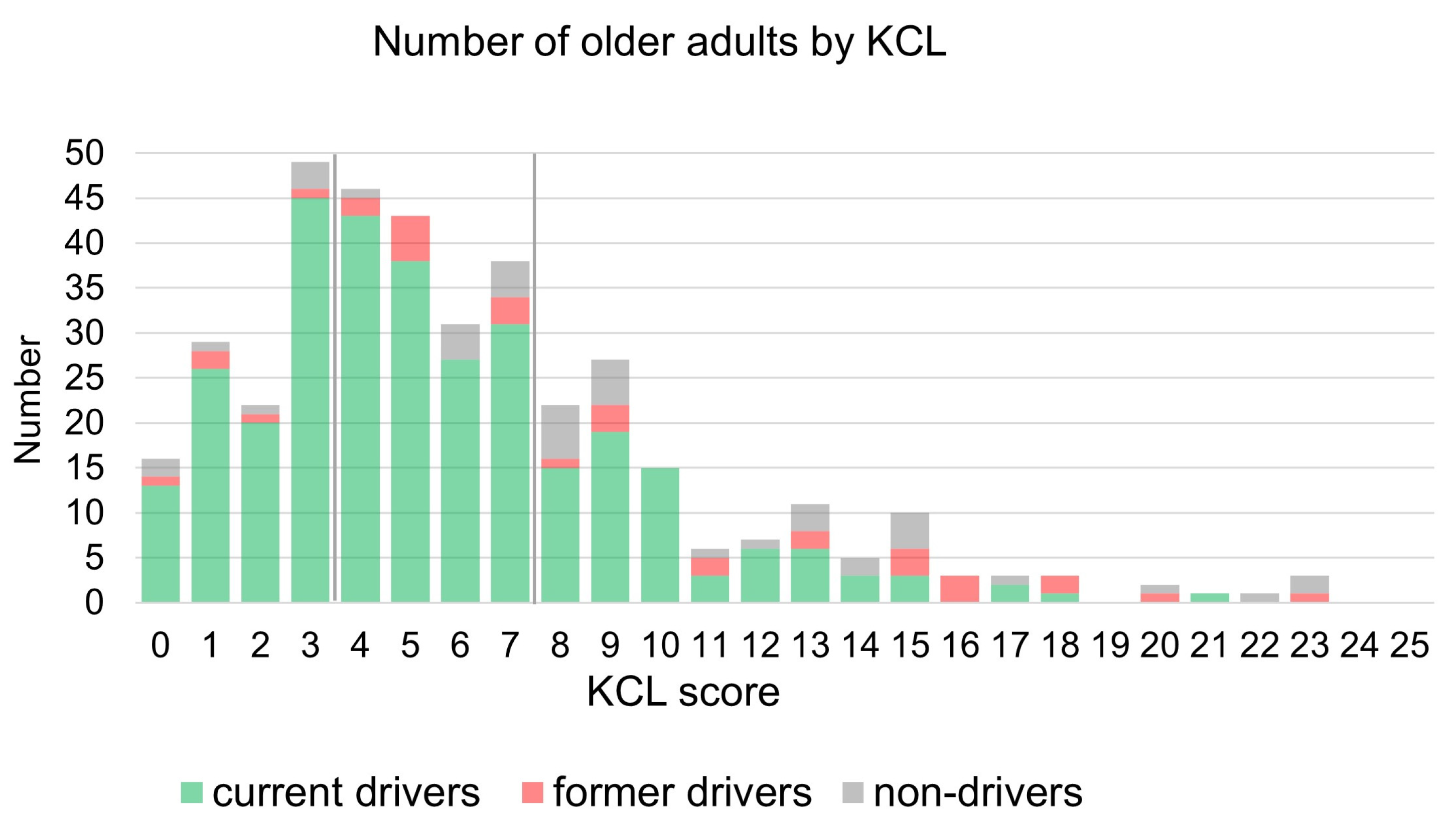


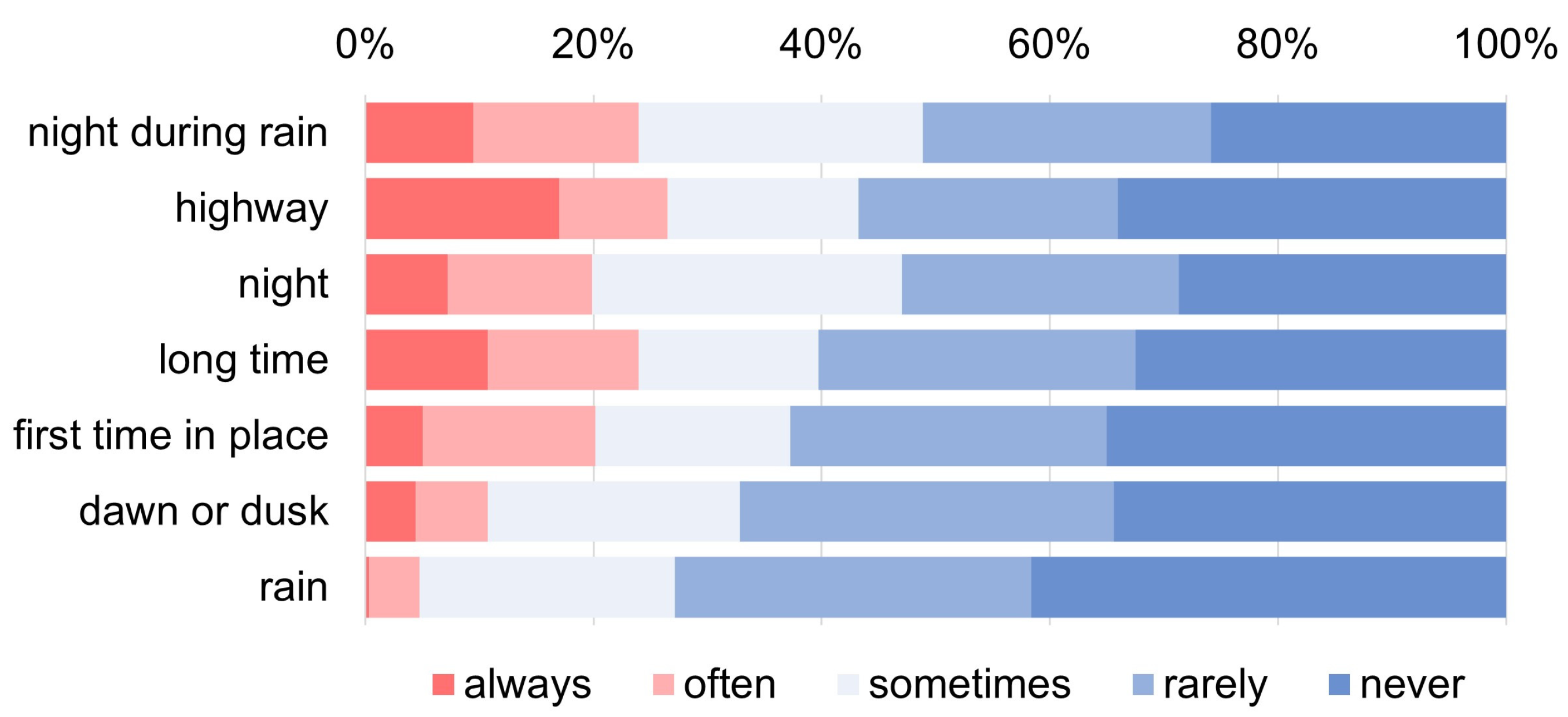
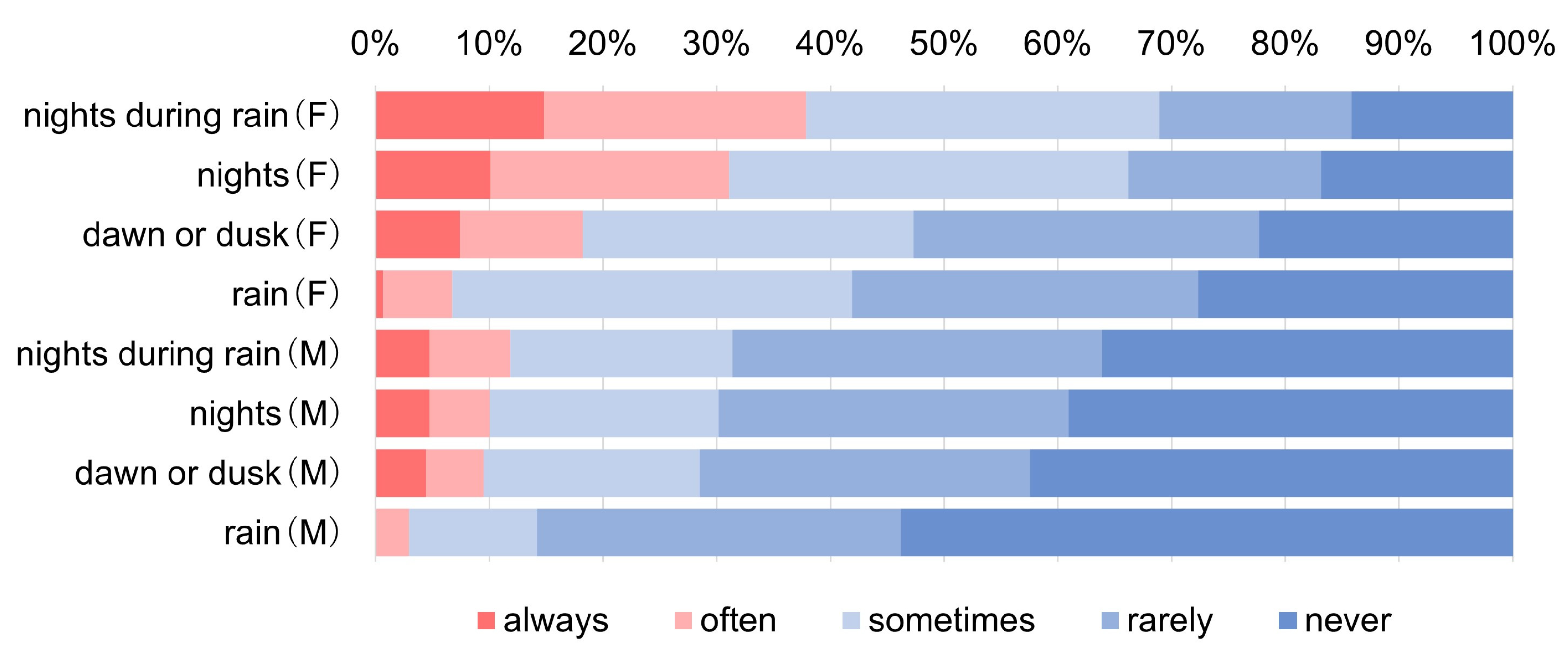
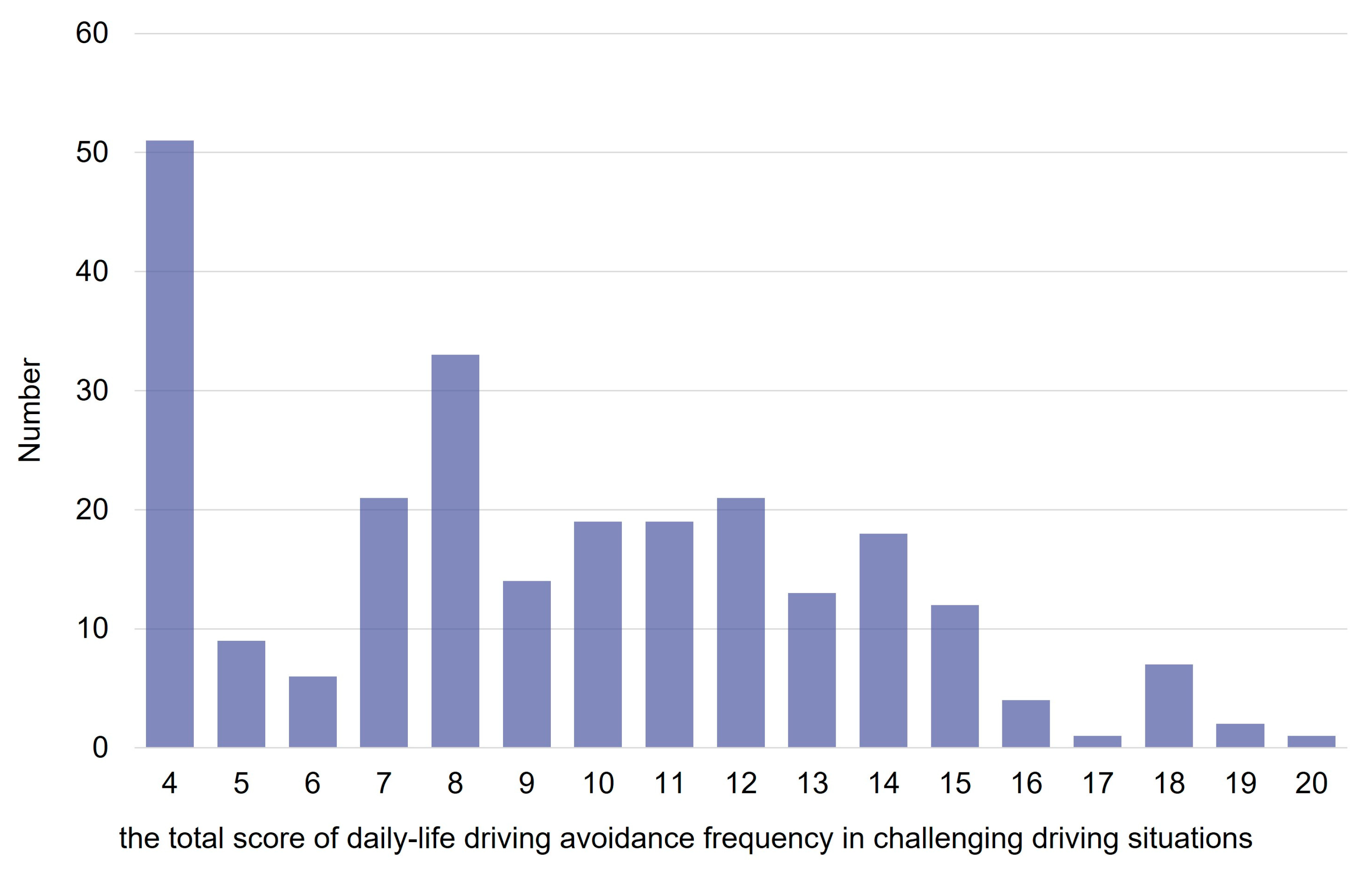
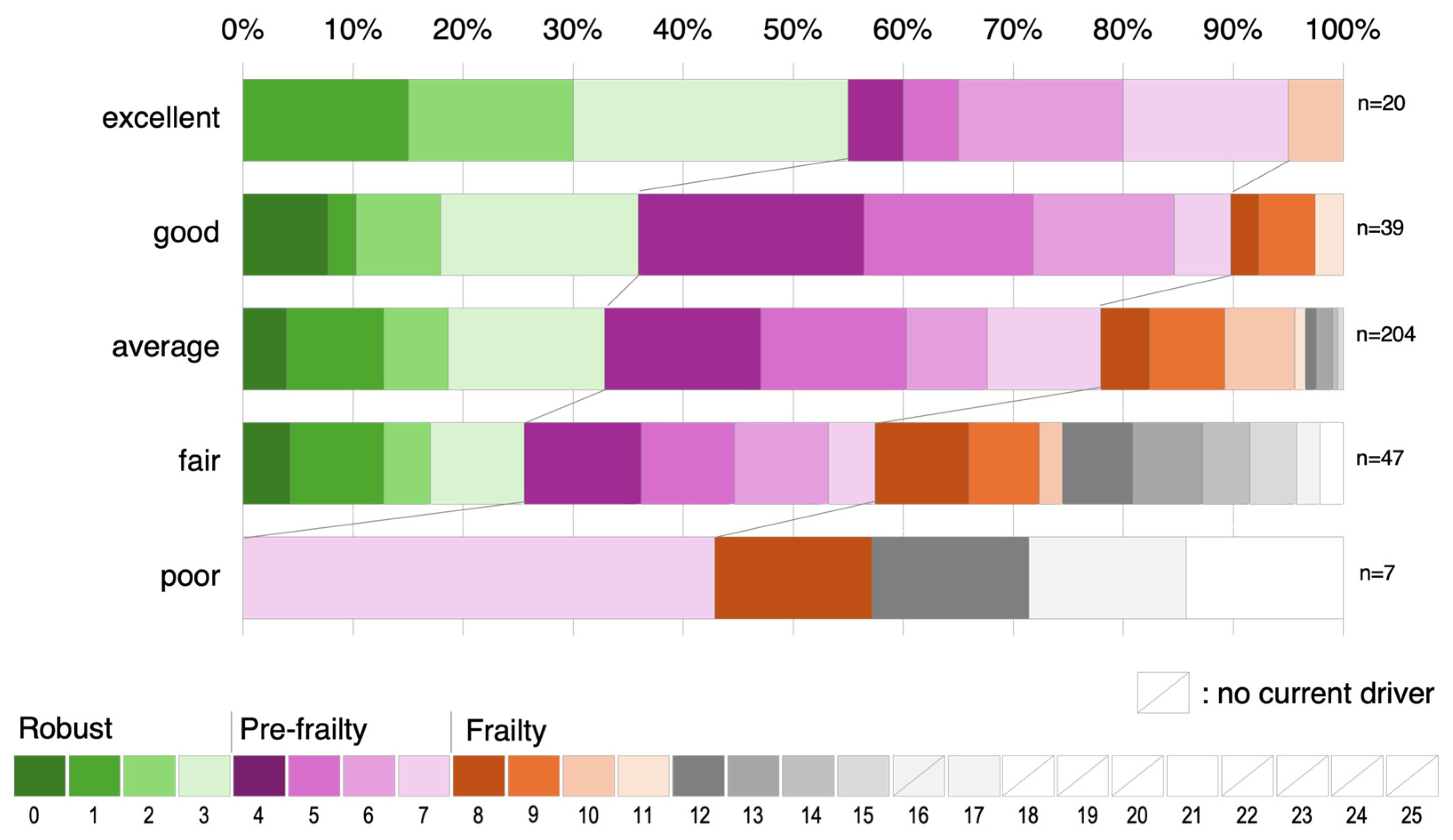
| Respondents (n = 393) | Current Drivers (n = 317) | Former Drivers (n = 33) | Non-Drivers (n = 43) | |||
|---|---|---|---|---|---|---|
| Gender | ||||||
| Male | 169 | 53.3% | 12 | 36.4% | 3 | 7.0% |
| Female | 148 | 46.7% | 21 | 63.6% | 40 | 93.0% |
| Age | ||||||
| 65–69 | 96 | 30.3% | 0 | 0.0% | 2 | 4.7% |
| 70–74 | 102 | 32.2% | 3 | 9.1% | 6 | 14.0% |
| 75–79 | 59 | 18.6% | 4 | 12.1% | 7 | 16.3% |
| 80–84 | 40 | 12.6% | 13 | 39.4% | 6 | 14.0% |
| 85–89 | 15 | 4.7% | 3 | 9.1% | 11 | 25.6% |
| 90–94 | 3 | 0.9% | 6 | 18.2% | 6 | 14.0% |
| 95–99 | 2 | 0.6% | 4 | 12.1% | 5 | 11.6% |
| Region (bus) | ||||||
| Yes | 231 | 72.9% | 25 | 75.8% | 33 | 76.7% |
| No | 86 | 27.1% | 8 | 24.2% | 10 | 23.3% |
| Living alone | ||||||
| Yes | 62 | 19.6% | 15 | 45.5% | 14 | 32.6% |
| No | 255 | 80.4% | 18 | 54.5% | 29 | 67.4% |
| Frailty Measures | ||||||
| Robust | 104 | 32.8% | 5 | 15.2% | 7 | 16.3% |
| Pre-frailty | 139 | 43.8% | 10 | 30.2% | 9 | 20.9% |
| Frailty | 74 | 23.3% | 18 | 54.5% | 27 | 62.8% |
| KCL scores | ||||||
| Mean (SD) | 5.44 (3.60) | 9.58 (6.12) | 9.67 (5.87) | |||
| Median [Min, Max] | 5.00 [0, 21.0] | 9.00 [0, 23.0] | 8.00 [0, 23.0] | |||
| Model 1 | Model 2 | Model 3 | |
|---|---|---|---|
| Age (5-year) OR (95%CI) | 3.056 *** (2.612–6.776) | 3.187 *** (2.255–4.834) | 3.263 *** (2.338–4.860) |
| Gender | |||
| Male OR (95%CI) | 1.000 (Ref) | 1.000 (Ref) | 1.000 (Ref) |
| Female OR (95%CI) | 6.011 ** (1.989–21.763) | 5.452 ** (1.848–18.855) | 4.719 ** (1.712–14.723) |
| Living alone | |||
| Yes OR (95%CI) | 2.616 (0.985–7.029) | 2.687 * (1.018–7.199) | 2.659 * (1.052–6.784) |
| No OR (95%CI) | 1.000 (Ref) | 1.000 (Ref) | 1.000 (Ref) |
| KCL scores OR (95%CI) | 1.160 ** (1.059–1.277) | ||
| Frailty Measures | |||
| Robust OR (95%CI) | 1.000 (Ref) | ||
| Pre-frailty OR (95%CI) | 1.108 (0.327–4.104) | ||
| Frailty OR (95%CI) | 3.875 * (1.215–14.126) | ||
| AIC | 139.610 | 144.200 | 147.830 |
| Model 1 | Model 2 | Model 3 | |||||
|---|---|---|---|---|---|---|---|
| Driving | Not driving | Driving | Not driving | Driving | Not driving | Total | |
| Current | 311 | 6 | 311 | 6 | 314 | 3 | 317 |
| Former | 21 | 12 | 22 | 11 | 25 | 8 | 33 |
| Total | 332 | 18 | 333 | 17 | 339 | 11 | 350 |
| Male | Female | p-Value | |
|---|---|---|---|
| n = 169 | n = 148 | ||
| Riding in a car driven by others | <0.001 a | ||
| No | 158 (93.5%) | 113 (76.4%) | |
| Yes | 11 (6.5%) | 35 (23.6%) | |
| Self-rating of driving ability | 0.066 a | ||
| Excellent | 14 (8.3%) | 6 (4.1%) | |
| Good | 23 (13.6%) | 16 (10.8%) | |
| Average | 112 (66.3%) | 92 (62.2%) | |
| Fair | 17 (10.1%) | 30 (20.3%) | |
| Poor | 3 (1.8%) | 4 (2.7%) | |
| Evaluate the importance of driving | 0.011 b | ||
| Very important | 121 (71.6%) | 82 (55.4%) | |
| Important | 38 (22.5%) | 51 (34.5%) | |
| Somewhat important | 10 (5.9%) | 11 (7.4%) | |
| Not very important | 0 (0%) | 3 (2.0%) | |
| Not important at all | 0 (0%) | 1 (0.7%) | |
| Current driving frequency | <0.001 a | ||
| Nearly daily | 86 (50.9%) | 23 (15.5%) | |
| 3–5 times weekly | 44 (26.0%) | 63 (42.6%) | |
| 1–2 times weekly | 32 (18.9%) | 45 (30.4%) | |
| 2–3 times monthly | 6 (3.6%) | 17 (11.5%) | |
| Not driven in the past six months | 1 (0.6%) | 0 (0%) |
| Challenging Daily-Life Driving Situations | Challenging Non-Daily-Life Driving Situations | ||||||
|---|---|---|---|---|---|---|---|
| Rain | Nights | Dawn or Dusk | Nights During Rain | Long Time | First Time in Place | Highways | |
| rain | 1 | 0.71 | 0.63 | 0.70 | 0.54 | 0.58 | 0.49 |
| nights | 1 | 0.79 | 0.89 | 0.60 | 0.64 | 0.56 | |
| dawn or dusk | 1 | 0.77 | 0.62 | 0.64 | 0.55 | ||
| nights during rain | 1 | 0.63 | 0.64 | 0.57 | |||
| long time | 1 | 0.77 | 0.66 | ||||
| first time in place | 1 | 0.72 | |||||
| highways | 1 | ||||||
| Model A | Model B | Model C | Model D | |
|---|---|---|---|---|
| Female | 2.926 *** | 2.822 *** | 3.195 *** | 3.155 *** |
| (95% CI) | (2.139, 3.712) | (2.017, 3.627) | (2.396, 3.995) | (2.318, 3.991) |
| Age | 0.425 ** | 0.456 ** | 0.389 * | 0.419 * |
| (95% CI) | (0.119, 0.731) | (0.143, 0.770) | (0.074, 0.703) | (0.090, 0.748) |
| Living alone, yes | 1.100 * | 1.104 * | 1.113 * | 1.125 * |
| (95% CI) | (0.129, 2.071) | (0.108, 2.100) | (0.114, 2.113) | (0.080, 2.170) |
| Self-rating of driving ability | 1.161 *** | 1.487 *** | ||
| (95% CI) | (0.642, 1.681) | (0.979, 1.996) | ||
| KCL scores | 0.236 *** | 0.310 *** | ||
| (95% CI) | (0.124, 0.348) | (0.200, 0.420) | ||
| R2 | 0.291 | 0.251 | 0.247 | 0.173 |
| Adjusted R2 | 0.279 | 0.242 | 0.237 | 0.165 |
| AIC | 1697.004 | 1712.060 | 1713.992 | 1741.777 |
| BusRoute Area | Live Alone | KCL Scores | SRDA | EID | TS DAF | Usual Driving Destination | Current Using Transportation | Future Using Transportation * | ||||
|---|---|---|---|---|---|---|---|---|---|---|---|---|
| Kushiro | Village | Others | Public * | Others | Public * | |||||||
| Must-watch drivers (n = 6) | 17% | 33% | 9.6 | 3.5 | 1.5 | 11 | 83% | 83% | 33% | 0% | 67% | 67% |
| Former drivers (n = 33) | 24% | 45% | 10.8 | 76% | 58% | 79% | 42% | |||||
| Other current drivers (n = 311) | 27% | 19% | 5.3 | 2.9 | 1.5 | 9 | 86% | 64% | 14% | 4% | 56% | 83% |
| p-value | 0.945 a | 0.001 a | <0.001 b | 0.118 c | 0.981 c | 0.322 c | 1.000 a | 0.427 a | <0.001 a | <0.001 a | 0.028 a | <0.001 a |
Disclaimer/Publisher’s Note: The statements, opinions and data contained in all publications are solely those of the individual author(s) and contributor(s) and not of MDPI and/or the editor(s). MDPI and/or the editor(s) disclaim responsibility for any injury to people or property resulting from any ideas, methods, instructions or products referred to in the content. |
© 2024 by the authors. Licensee MDPI, Basel, Switzerland. This article is an open access article distributed under the terms and conditions of the Creative Commons Attribution (CC BY) license (https://creativecommons.org/licenses/by/4.0/).
Share and Cite
He, M.; Yamanaka, Y.; Takamatsu, K. Possibility to Grasp the Older Drivers’ Conditions from the Triennial Nationwide Survey of Japan for Elderly Welfare. Int. J. Environ. Res. Public Health 2025, 22, 5. https://doi.org/10.3390/ijerph22010005
He M, Yamanaka Y, Takamatsu K. Possibility to Grasp the Older Drivers’ Conditions from the Triennial Nationwide Survey of Japan for Elderly Welfare. International Journal of Environmental Research and Public Health. 2025; 22(1):5. https://doi.org/10.3390/ijerph22010005
Chicago/Turabian StyleHe, Mengmeng, Yasuhiro Yamanaka, and Kazuya Takamatsu. 2025. "Possibility to Grasp the Older Drivers’ Conditions from the Triennial Nationwide Survey of Japan for Elderly Welfare" International Journal of Environmental Research and Public Health 22, no. 1: 5. https://doi.org/10.3390/ijerph22010005
APA StyleHe, M., Yamanaka, Y., & Takamatsu, K. (2025). Possibility to Grasp the Older Drivers’ Conditions from the Triennial Nationwide Survey of Japan for Elderly Welfare. International Journal of Environmental Research and Public Health, 22(1), 5. https://doi.org/10.3390/ijerph22010005





